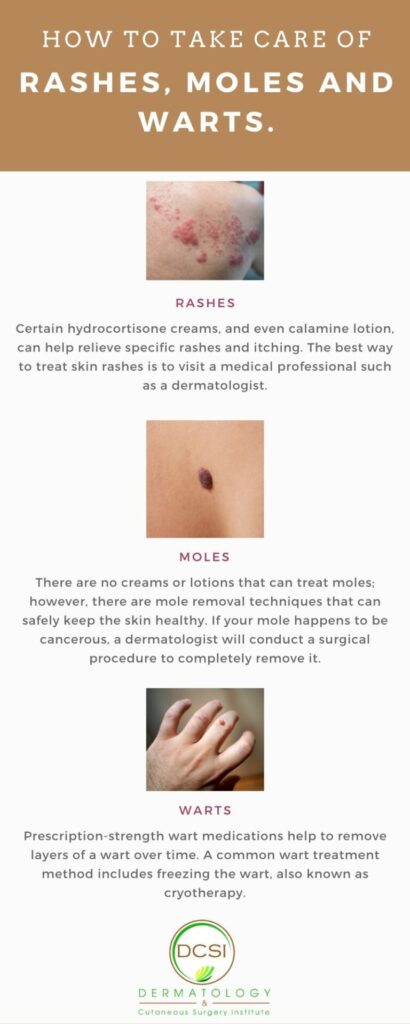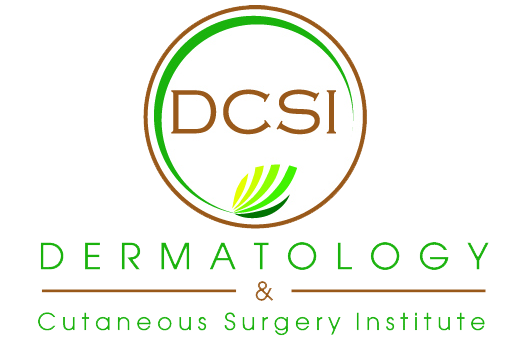Wart and Mole Removal
Moles and warts are common skin growths that can cause frustration and embarrassment for many people. Moles are typically dark, raised spots on the skin, while warts are small, rough bumps caused by a viral infection. While these growths are usually normal, they can be unsightly or even uncomfortable, leading many people to seek ways to remove them. In this blog we’ll explore various methods of wart and mole removal as well as the treatment of skin rashes. Whether you’re dealing with a single stubborn growth or a cluster of unsightly blemishes, our team at DCSI hopes to provide you with the information you need to make an informed decision about your skin health.
If you notice any irregularities or changes to moles on your body, it’s important to consult with a skin doctor, such as our South Florida Dermatologists, right away. There are many different types of skin rashes that can appear on the body and they can all mean different things. For instance, an itchy rash that does not subside should be looked at by a dermatologist. Warts are areas of your skin that grow faster than normal due to a virus, so if you notice any growth, contact our experts. There are multiple surgical dermatology treatments available at our offices that include wart removal.
How to Get Rid of Skin Moles
As discussed, skin moles are a common occurrence that can appear anywhere on the body. If you have a mole that you would like to remove, there are several methods available. Let’s take a look at some of the methods for wart and mole removal on the face and body.
- Surgical Removal: This is a very common procedure that involves cutting the mole off with a scalpel or surgical punch. The procedure is usually quick and painless and can be done under local anesthesia. There is a risk of mole removal scars or infection following the procedure, so the healing time should be ample so as to not get any infections.
- Laser Treatment: With this method, a laser is used to burn off the mole, layer by layer. This method is less invasive than surgery and typically does not require any anesthesia.
- Natural Remedies: A common natural remedy for mole removal is applying apple cider vinegar to daily for several weeks. Another option is to apply a mixture of baking soda and castor oil to the mole then covering it with a bandage. While less invasive, these methods generally take longer to work.
- Cryotherapy: Freezing the mole with liquid nitrogen causes the mole to blister and fall off. This can be a more painful procedure, so keep that in mind when browsing your options.
- Mole Removal Creams: Over-the-counter topical creams can be successful in mole removal. Creams that contain acid prove to be the most effective. This method, however, can also take a long period of time to show results.
Mole and wart removal can be quite costly. Mole removal costs can vary from doctor to doctor or treatment to treatment. On average, the cost of removing a mole is around $150 – $400. However, this depends on the size and location of the mole as well as any outpatient services the individual may require following treatment.
Skin Tag vs Wart

Skin tags and warts are both common skin growths, but they are not the same. While they are both benign skin growths, skin tags are soft and typically hang off the skin while warts are rough and caused by a viral infection. Skin tags do not spread, while warts can spread to other parts of the body.
Skin Tags
A skin tag, also known as an acrochordon, is a small, soft growth of the skin that hangs off the body. They are typically flesh-colored or slightly darker and can range in size from a few millimeters to a few centimeters. Skin tags are benign and usually painless, and can occur in areas where skin rubs against skin, such as the neck, underarms, or groin. They do not typically spread to other parts of the body.
Warts
A wart, on the other hand, is a small, rough growth on the skin caused by a viral infection. Warts can be flat or raised and are typically flesh-colored, white, or pink. They can occur anywhere on the body but are commonly found on the hands, feet, and face. Warts can be painful, especially when they are located on weight-bearing areas such as the soles of the feet. Warts can also spread to other parts of the body through contact with a virus such as HPV, or Human Papilloma Virus.
Skin Rashes
Skin rashes are skin conditions that do not necessarily occur from an underlying disease. Certain causes may include hot weather, direct exposure to the sun, and certain clothing material. For instance, hives are a type of skin rash that is triggered by an allergic reaction to food or medication. If you are allergic to dust, pollen, or a specific food, you may break out in itchy hives when you’re exposed to any of these allergens.
The most common skin rashes include eczema, psoriasis, rosacea, and shingles. There are many ways to address these, but the best way to treat skin rashes is to visit a medical professional such as a dermatologist. The doctor will be able to fully assess the condition and provide you with the best option for treating skin rashes.
Skin rash creams for adults are also common for the treatment of irritating rashes. Certain hydrocortisone creams and essential oils for skin rash can help relieve specific rashes and itching. Skin rash treatment creams can go a long way and would be able to hold you off for a little if you don’t have the time to see a doctor right away.
Choose Our Dermatology Center Today!
If you’re concerned about a possible skin condition, our Delray Beach dermatology center can help you immediately. Doctor Mounir Wassef is a board-certified dermatologist with years of experience treating patients for wart and mole removal. If you have any further questions, contact our team today and feel free to call our Wellington clinic at 561-246-1791 or the Delray clinic at 561-637-0222!

